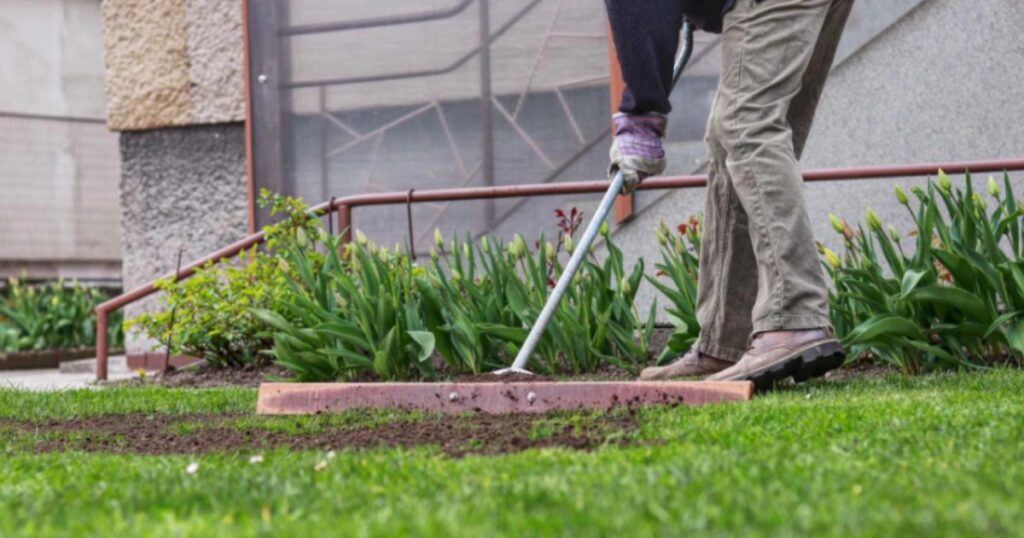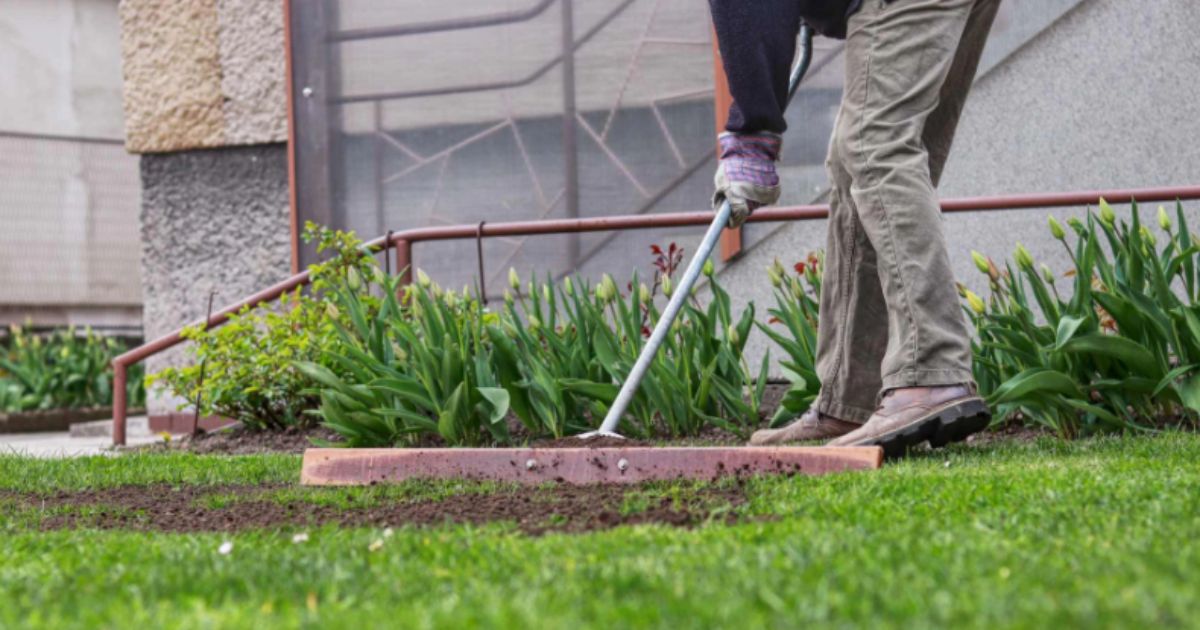As an Amazon Associate, I earn from qualifying purchases
Level Your Lawn: Soil level means adding soil to those low areas in your lawn so everything is on the same plane. This process creates an even surface for your yard.
The lawn is much nicer when it’s flat and it helps the grass to grow well without making mowing such a big chore. The root of the implant protrusion is that there’s no leveling yet, and rather than proceed with patching up, we have to understand why the original surface is so blobby. Drainage, soil erosion, and repair settling are among the most common causes. After you have found out what went wrong, then you can begin the process of leveling your garden.
We will be talking about ways to level your lawn, such as topdressing, soil amendment, and/or grading. We will also share with you the secret of keeping your lawn perfectly level.

Why Is It Important to Level a Yard?
Leveling a yard is important for both aesthetic and practical reasons. An even lawn enhances the overall appearance of your outdoor space, giving it a polished and well-maintained look.
Beyond appearance, leveling helps with proper water drainage, preventing water from pooling in low areas that can lead to soggy patches, soil erosion, or even damage to your home’s foundation.
Assessment
Assessment is the first step in leveling your lawn to ensure a healthy and even surface for your outdoor space. Proper assessment involves
Checking For Uneven Areas
You can also use a long, straight board or a level to detect slight changes in the lawn’s surface. Lay the board flat on the ground in different sections of the yard, and if you notice gaps beneath it, those areas may need filling.
Mark these uneven spots with small flags or stakes so you can easily return to them during the leveling process. Identifying these areas early ensures you focus your efforts.
Identifying Drainage Issues
To do this, first, go out into your yard after a hard rain. Poor water flow — Standing water or slow drainage in specific places Pooling low areas or slopes that leave from your home may also be signs of poor drainage.
A sudden elevation change may be a sign of erosion, but swelling soil and compaction or dying grass can indicate inadequate drainage. From there, you can alleviate the true causes with proper grading and site preparation, soil amendments, or put in place a drainage solution like French drains.
Checking For Uneven Areas
1. Walk around your lawn to feel for any uneven spots that may be present.
2. Use a long, straight board to check for dips or bumps across the lawn.
3. Create a simple sketch of the lawn to mark areas that need attention.
Identifying Drainage Issues
1. Look for puddles of water or areas that remain soggy after rainfall.
2. Check if water is running off quickly in certain spots, indicating poor drainage.
3. Consider installing french drains or adjusting the slope to address drainage problems.
Preparation
Before leveling your lawn, proper preparation is essential to ensure a successful outcome. This involves gathering the necessary tools and clearing the area to create a clean and even surface for the leveling process.
Gathering Necessary Tools
Before beginning the leveling process, make sure to gather all the necessary tools required for the task. This includes:
- Leveling rake
- Soil conditioner
- Wheelbarrow
- Shovel
- Water hose
Clearing The Area
Clearing the area is crucial to creating an ideal surface for leveling. This involves:
-
- Removing any debris such as rocks, branches, and other obstacles from the lawn.
- Trimming the grass to a short height to allow for easier leveling.
- Addressing any existing drainage issues to prevent future problems.
Leveling Techniques
Ensuring your lawn is level is essential for a healthy and visually appealing outdoor space. Here are some effective techniques to level your lawn:
Topdressing With Soil
Topdressing with soil is a simple and effective method for leveling your lawn. This technique involves spreading a thin layer of topsoil over the entire lawn surface.
The topsoil helps to fill in low spots and even out the surface, promoting healthy grass growth. It’s important to choose high-quality, weed-free topsoil for this process.
Using A Roller Or Lawn Leveling Rake
Using a roller or lawn leveling rake can help to smooth out uneven areas on your lawn. A roller can be filled with water to add weight, which aids in pressing down bumps and leveling the surface.
On the other hand, a lawn leveling rake is designed to redistribute soil, making high spots lower and low spots higher. Both tools are effective for achieving a more uniform lawn surface.
Seeding And Sodding
When it comes to leveling your lawn, the process of seeding and sodding plays a crucial role in achieving a lush, green lawn.
Both methods have their own advantages and choosing the right one for your lawn can make a significant difference in the overall outcome.
Choosing The Right Grass Seed
Selecting the right grass seed is essential for a successful lawn seeding. Consider the climate, soil type, and the amount of sunlight your lawn receives. It’s advisable to choose a high-quality, disease-resistant grass seed that is well-suited to your specific conditions.
Laying Sod For Instant Results
Laying sod can provide instant gratification, giving you an immediately green lawn. It’s crucial to prepare the soil thoroughly before laying the sod to ensure proper root establishment.
Choose fresh, healthy sod that is free of weeds and pests for the best results. Proper watering and maintenance are essential to help the sod establish and integrate with the existing soil.
Watering And Maintenance
Lawn maintenance involves a combination of tasks, with watering and regular maintenance being crucial for a healthy, lush lawn. By following a proper watering schedule and consistently maintaining the lawn, you can ensure its optimal growth and appearance.
Proper Watering Schedule
A proper watering schedule is essential for the overall health of your lawn. It is recommended to water your lawn early in the morning, as this allows the water to penetrate the soil before the heat of the day causes evaporation.
Water deeply but infrequently, ensuring the soil is moistened to a depth of 6-8 inches. Avoid frequent shallow watering, as this can lead to shallow root growth. Use a sprinkler system or a water timer to maintain a consistent watering schedule.
Regular Mowing And Edging
Regular mowing and edging are essential for maintaining a neat and tidy lawn. Mow your lawn at the appropriate height for your grass type, ensuring you do not cut more than one-third of the grass blade length at a time.
Regular edging helps to maintain clean and defined borders, enhancing the overall appearance of your lawn. Removing weeds and debris from the edges also prevents them from encroaching on the lawn.
Dealing With Common Issues
Fixing Patches And Bare Spots
Fixing patches and bare spots in your lawn is essential for maintaining a healthy, lush yard. Start by loosening the soil in the affected areas with a rake or garden fork to improve root penetration. Remove any debris, weeds, or dead grass to give new growth a clean space to thrive. Apply a layer of topsoil or compost to fill in the bare spots and ensure the ground is level.
Then, spread grass seed evenly over the area, making sure to choose a seed type that matches your existing lawn. Lightly cover the seed with soil, water it thoroughly, and keep the area moist until the grass begins to grow. Avoid foot traffic on the repaired spots until the grass is well-established.
Managing Soil Compaction
Managing soil compaction is vital for maintaining a healthy lawn, as compacted soil restricts water, air, and nutrients from reaching grass roots, leading to poor growth and drainage issues. To manage compaction, start by testing your soil by pushing a garden fork or screwdriver into the ground.
Aerating your lawn is the best solution. Use a core aerator to remove small plugs of soil, which loosens the ground and improves airflow. For heavily compacted areas, you may need to aerate twice a year. After aerating, apply compost or topdressing to fill the holes and boost soil quality.
Seasonal Considerations
In order to maintain a lush and healthy lawn, it is crucial to consider the different needs of your lawn throughout the year. By understanding the Seasonal Considerations, you can implement the right lawn care practices at the appropriate times to ensure your lawn thrives.
Spring Lawn Care Tips
- Aerate your lawn to allow air, water, and nutrients to reach the roots.
- Overseed bare patches to promote a thick and healthy lawn.
- Apply a slow-release fertilizer to encourage growth and green-up.
- Keep your lawn well-watered to support new growth.
Fall Maintenance For A Healthy Lawn
- Rake and remove leaves to prevent suffocation of grass.
- Continue mowing until grass stops growing to prevent thatch buildup.
- Apply a fall fertilizer to promote root growth and winter hardiness.
- Aerate to reduce compaction and improve water infiltration.

Professional Help
Elevate your lawn’s appearance with professional help for leveling uneven terrain. Expert services ensure a smooth and even surface, promoting healthy grass growth. Enhance your outdoor space effortlessly with tailored solutions for a picture-perfect lawn.
When To Consult A Landscaping Expert
- It is essential to consult a landscaping expert when your lawn requires extensive work or specialized knowledge.
- Signs that you may need professional help include uneven terrain, persistent weed issues, or poor grass growth.
- An expert can assess the condition of your lawn and provide tailored solutions to achieve optimal results.
Cost Considerations
- When considering professional help, evaluate the cost based on the scope of work needed for your lawn.
- Factors such as size of the lawn, extent of repairs, and additional services will impact the overall cost.
- Obtain multiple quotes from landscaping experts to compare prices and services offered before making a decision.
- While the cost of professional help may vary, investing in expert assistance can ensure a well-leveled lawn in the long run.
Frequently Asked Questions
Quest: What Is The Easiest Way To Level A Lawn?
Ans: The easiest way to level a lawn is by using a lawn roller or topdressing with soil. You can also use a lawn leveling rake for smaller areas.
Quest: How Do You Flatten A Bumpy Lawn?
Ans: To flatten a bumpy lawn, you need to start by removing any rocks or debris. Then, aerate the lawn to loosen the soil. Fill in any low areas with soil and level the surface.
Quest: Can You Put Soil On Top Of Grass To Level?
Ans: Yes, you can put soil on top of grass to level it, but it is not recommended. The soil will eventually settle, leaving an uneven surface.
Conclusion
Leveling your lawn is a rewarding process that improves the appearance, health, and functionality of your yard. By identifying uneven areas, addressing drainage issues, and using the right tools and materials, you can create a smooth, even surface perfect for outdoor activities and landscaping.
Regular maintenance, such as aerating and fixing bare spots, will keep your lawn looking its best long after leveling. With patience and attention to detail, you can transform your yard into a beautiful, flat space that enhances your home’s curb appeal and makes lawn care more manageable.
As an Amazon Associate, I earn from qualifying purchases

